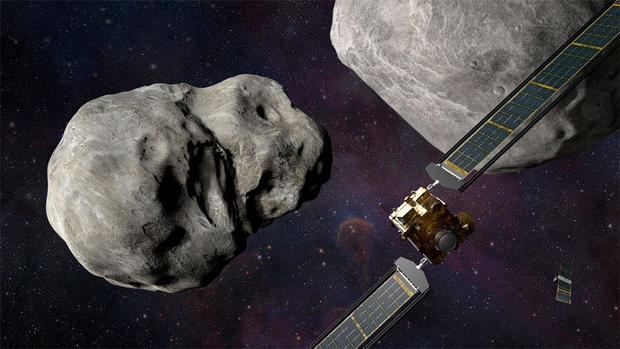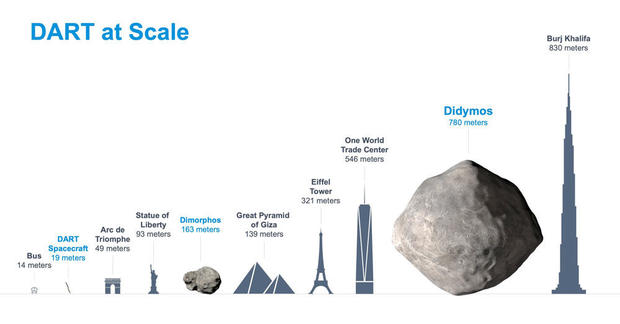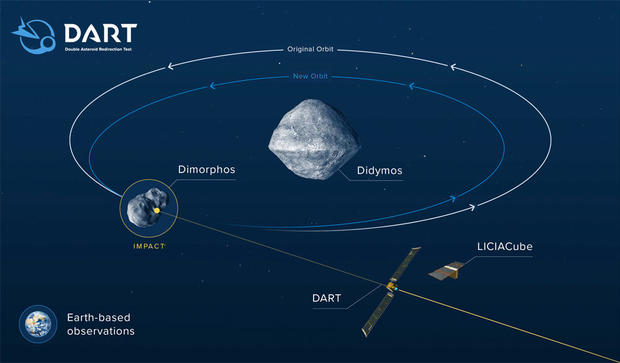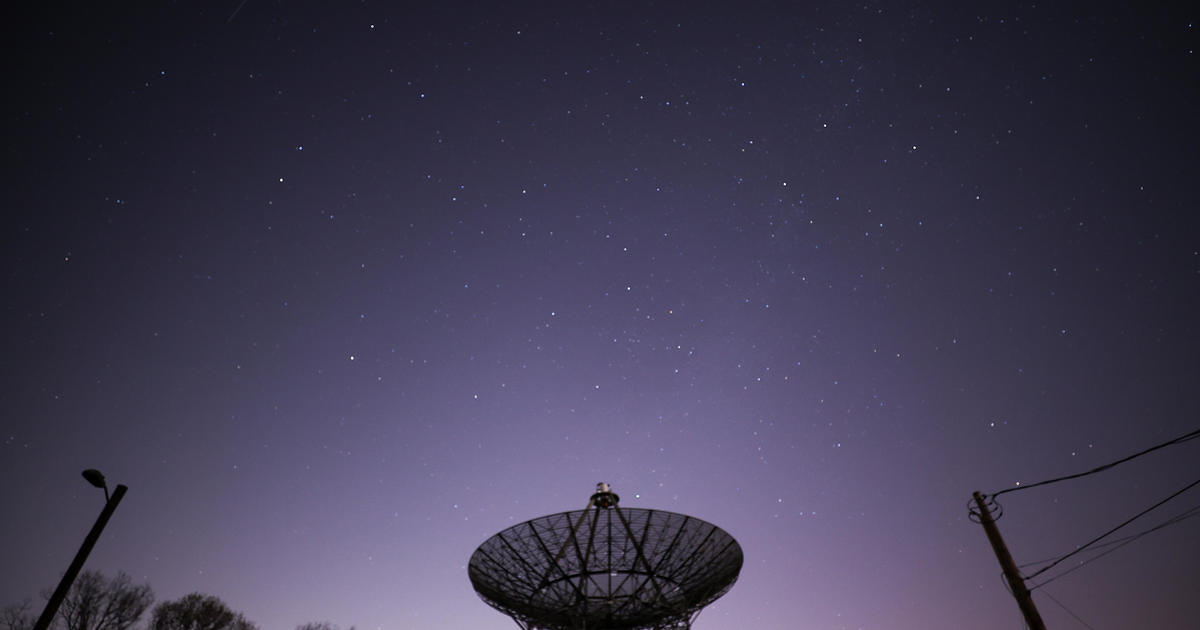NASA counts down to first test of "planetary defense" against asteroids
NASA is launching a small probe Wednesday that will crash head-on into a small asteroid next fall at some 15,000 mph to test the feasibility of one day nudging a threatening body off course just enough to prevent a catastrophic impact on Earth.
The $330 million Double Asteroid Redirection Test, or DART, "will be historic," said Tom Statler, mission program scientist at NASA Headquarters. "For the first time, humanity will change the motion of a natural celestial body in space."
The 525-foot-wide target asteroid, known as Dimorphos, is actually a small moon orbiting a half-mile-wide parent body named Didymos. Neither poses any threat to Earth, either before or after the DART encounter.
DART is targeting a double-asteroid system because the probe's impact can be more easily measured from Earth by precisely timing how the moonlet's orbital period around Didymos changes as a result of the collision.
And what a collision it will be.
The 1,210-pound DART spacecraft is expected to slam into Dimorphos at a blistering 15,000 mph, disintegrating on impact as it gouges out a fresh crater and, in the process, slows the body by a minuscule fraction of an inch per second.
The probe is programmed to beam back high-resolution images once every second in the final stages of its kamikaze approach, covering the last 1,000 miles in just 4 minutes.
A small Italian hitchhiker spacecraft known as LICIACube, released from DART 10 days before impact, will attempt to photograph the collision and the debris blasted back out into space. At the moment of impact, Didymos and Dimorphos will be about 6.8 million miles from Earth.
Unlike Hollywood thrillers like "Armageddon" and "Deep Impact," which imagined piloted flights carrying nuclear bombs to deflect or destroy their targets, DART's goal is much simpler and much less destructive.
While nuclear devices might be a last resort in some future armageddon-class scenario, deflection, not destruction, would still be the goal.
"You just don't want to blow it up, because that doesn't change the direction of all the material," Lindley Johnson, NASA's "planetary defense" officer, told CBS News. "It's still coming at you, it's just buckshot instead of a rifle ball."
"What you want to do is just change the speed at which this is all moving by just a bit. Over time, that will change the position of the asteroid and its orbit."
Plans for launch and impact
Perched atop a SpaceX Falcon 9 rocket, the DART mission is scheduled for launch from Vandenberg Space Force Base northwest of Los Angeles at 10:20 p.m. PST Tuesday (1:20 a.m. EST Wednesday). Forecasters are predicting a 90% chance of acceptable weather.
The launching will mark SpaceX's 26th flight so far this year, its 128th Falcon 9 flight overall and its 18th from California. As usual for SpaceX, the company will attempt to recover the rocket's first stage with landing on an off-shore droneship.
Shortly after reaching orbit, DART's two 28-foot-long roll-out solar arrays will unwind and the craft will set off on a long, looping trajectory to catch up with its quarry next September 26. Along the way, the spacecraft will test a solar-powered xenon thruster that could save weight — and money — on future deep space probes.
If the probe's high-speed impact works as intended, Dimorphos' orbital velocity will decrease ever so slightly, shaving a few minutes or so off the 11 hours and 55 minutes it currently takes to complete one trip around Didymos. The minimum change for mission success is 73 seconds.
"Now that's a very small change, but it could all that's necessary to deflect an asteroid on a collision course with Earth if we should ever need to do that, provided we discover that asteroid early enough and we have enough lead time," said Statler.
Early discovery is critical, because the farther away a threatening body is when attempting a deflection, the less force is required to nudge it off course. DART is NASA's first so-called "planetary defense mission" and it's intended primarily to test the "kinetic impact" approach.
"DART is just this first step towards being able to potentially prevent asteroids from hitting the Earth in the future," Chabot said
Astronomers believe there are roughly 25,000 near-Earth asteroids 500 feet or larger in size.
For perspective, the body that blasted out Meteor Crater in Arizona was about 150 feet wide while the meteor that broke up over Chelyabinsk, Russia, in 2013, injuring more than 1,600 people and causing an estimated $30 million in damage, measured just 60 feet across.
"The ones that we're most concerned about right now are things that are a few hundred meters (across), and that's because we've found less than half of this population," said Nancy Chabot, chief planetary scientist at APL. "And so we're not really sure where all of them are."
"So along with finding these asteroids, figuring out where they are, tracking them, making sure that we're safe, we want to be prepared to potentially prevent them from hitting the Earth in the future."
To put a "few hundred meters" in perspective, Chabot said such an impact "would be devastating for tens to hundreds of kilometers, much worse than any nuclear bomb that's ever been used here on the planet.
"We're actually not talking, like, global extinction event, but regional devastation on the area that could wipe out a city or even a small state," she said. "And so it is a real concern. It is a real threat."







